LTA these days seems to be, as a pretty insightful friend in the enthu community (sg1820g, first featured in this comm talk post here) puts it, “speedrunning” a game called “getting hated by everyone”.
A recent development on the bus side of public transportation in Singapore is fanning the flames of controversy yet again, one year on from the previous round which saw a critical express link from Bukit Panjang to the city getting guttered and another Yishun-Marina Center route cut short into a loop. The rationale, LTA claimed, and still claims today for this round of service cuts, was that “passengers should be riding the Downtown MRT line”, and that these routes were “duplicating” the DTL, hence resulting in “unnecessary resource utilisation”. Thus, the aptly named “bus rationalisation” came in for the purpose of avoiding duplication between bus and rail lines.
This time though, the scale of the service cuts was much larger, one of which being so severe it reduced a major trunk route crossing the island down to a measly transfer remover long feeder service.
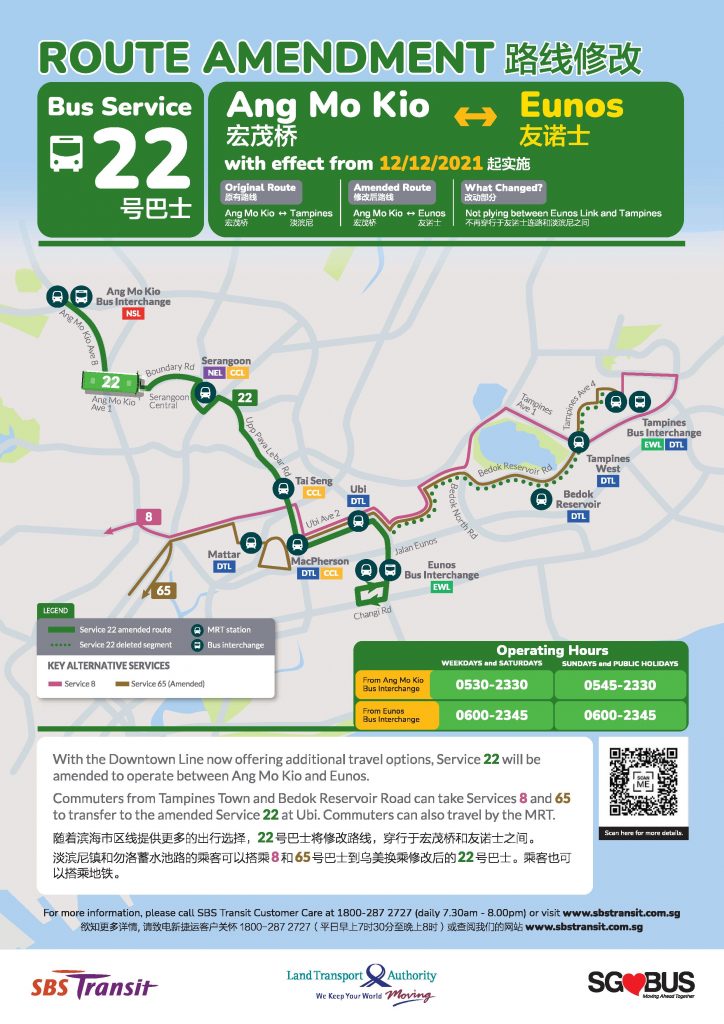

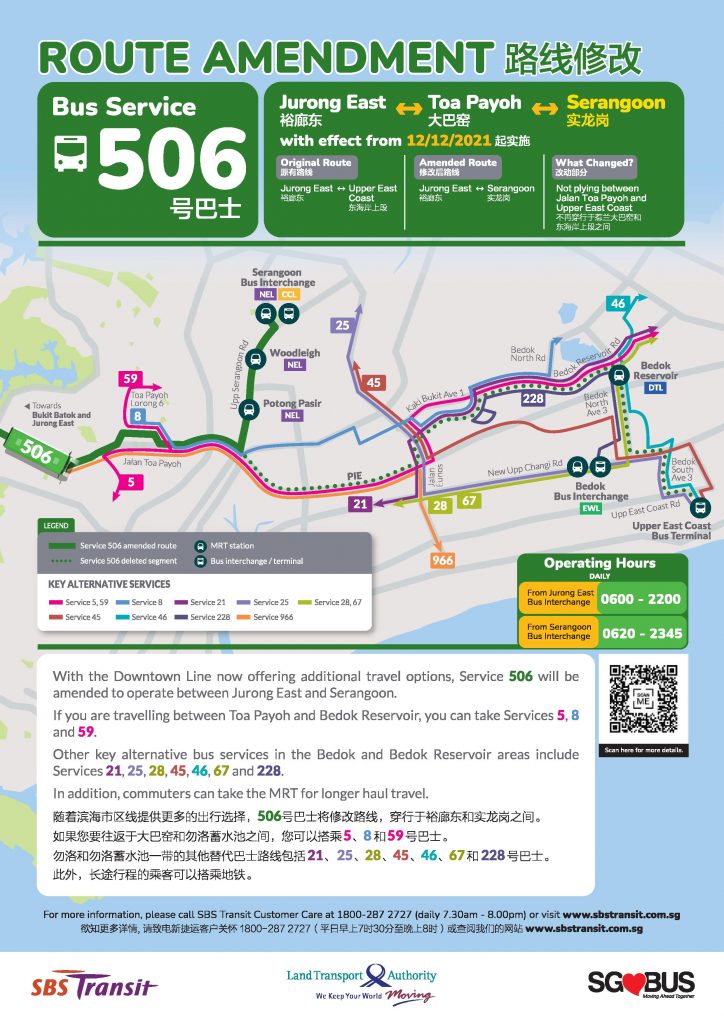
Another amendment in the series, which I won’t comment on too much detail since I wouldn’t exactly consider it a service cut yet.
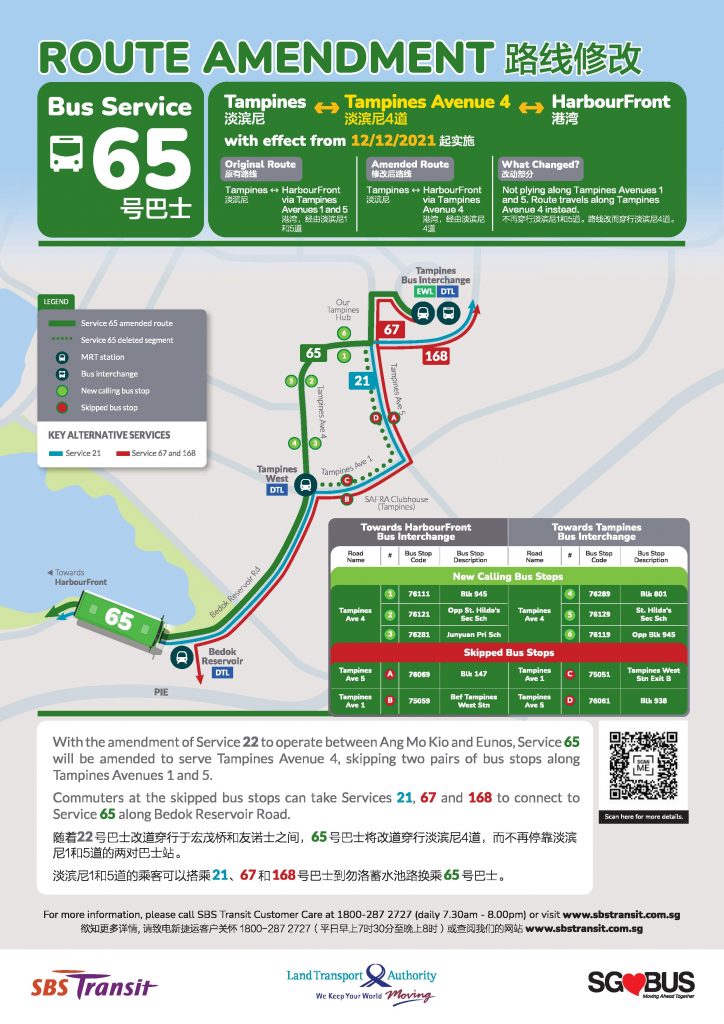
Needless to say, I am completely horrified. Not at how audaciously LTA is proceeding with such large-scale service cuts, but instead at the hints of LTA’s future plans that this one massive “amendment” (Say the right word please: service cut) exercise has exposed. I’m already fed up sufficiently with the former, anyways.
I’ll deal with the part on why bus rationalisation is a horrid idea and why it shouldn’t be practiced later. For now, let’s take a look at the negative ramifications these service cuts will bring about.
Lost connections
This effect is particularly pronounced for the cases of 66 and 506, which lost 75% and 40% of their route length respectively, as well as for the Bedok Reservoir region which stands to lose three entire routes’ worth of connectivity as a result of the shortenings.
Sure, you can talk about “alternative routes” (i.e. the thinner lines on all of those infographics that aren’t green in colour) and all that, but I think what is being missed here is the idea of trunk routes, and the role they play. Of course, from a theoretical standpoint you could still wander your way through the confusing mess of other bus routes to make up for what could have been a direct ride, through transferring multiple times between long feeders and feeders (what the heck is 228 doing on that 66 poster??) pretty much ruins the overall bus ride for most, unless you’re a bus hopper like me (and even then, I only have the appetite for it when I have 3 hours in a row to waste, something increasingly rare these days, bzzt).
What’s the difference between one direct bus ride through a continuous trunk route, and multiple bus rides through disjoint and scattered “other routes” to get to the same destination? Well, in the former case, you only have to wait for the bus, once, and assuming your bus driver is competent (which should be, in most cases), you can sit back and relax all the way. Whereas for the latter, you would have to wait for buses multiple times, and so even if the in-vehicle trip time remains the same, the overall trip time has increased as the time spent waiting for additional buses is longer than the time it would take for a single-seat journey all the way.
If you are a frequent transit user (or as the North Americans unflatteringly term, captive rider), the one single drawback of service cuts like these, is that it vastly reduces your scope of access in a given time!
Let’s say you live in MacPherson and intend to travel to Newton, and you only have 60 minutes to spare for the trip. With 66 still around, even if TTS was being a total jerk sending buses only once every 20 minutes, you would still be able to reach Newton in 40 minutes. On the contrary, if we removed this critical connector route, you would require SBST and SMRT to send their buses every ten minutes down services 65 and 67 respectively, and hope that the 67 arrives immediately after you step off the 65 at Jalan Besar! SMRT has always been doing okay-ish frequencies on 67, but SBST’s 65 may be slightly questionable… That is the power that trunk routes have, offering a through-route across longer distances, thereby reducing the number of transfers needed, and hence reducing your travel time!
Doesn’t sound very convincing? Here’s a more extreme case. Suppose you want to travel from Bedok South to Toa Payoh within an hour. With 506, even if it runs at its crappy 20-minute headways (standard practice for express routes), Toa Payoh lies within your comfortable one-hour travel range. If 506 is axed, your fastest route is now a two-step journey, first boarding bus 25 to Eunos Link, and then crossing the road and taking 59 to Toa Payoh. While the former runs at decent headways, the latter is exceptionally susceptible to bad frequency (and literally a horrendous fleet choice, B5LHs are arguably more claustrophobia-inducing than even the Citaro). In the former case, your waiting time is about 15 to 20 minutes. In the latter, your waiting time is at best 20 minutes (5 for 25 + 15 for 59) and at worst 35 minutes. This is before we factor into consideration the fact that 506 utilises expressways while your trunk + trunk option doesn’t, so while 40 minutes by 506 to Toa Payoh sounds feasible, 35 minutes by 25 and 59 on conventional roads sitting in mixed traffic, simply isn’t! Thus the removal of Service 506 effectively puts your destination out of range!
Bedok Reservoir is a particularly badly-afflicted location, with three routes going poof starting the 12th.
Here’s a sample of passing routes from a random Bedok Reservoir bus stop. As you can see, there’s quite a range of locations one is able to travel to with ease, and in an acceptable amount of time. (Jurong East travellers should be using 506 unless they’re like what TTS describes: enjoying long bus rides of up to 2.5 hours)

Here’s the same bus stop’s reach if the service cut goes to fruition:

Immediately one notices that travel options have been greatly reduced, and you’ll have to spend more time transferring between bus routes! Of course, most will eventually give up and take the Downtown Line instead, which is exactly LTA’s intention: to make trunk bus rides such a repulsive option that people eventually choose the ride the MRT instead, only viewing buses as “feeders” to get to the MRT station… all while the trains continue to break down, LTA profits more from dished-out fines, and rail operators left at a loss as ridership continues to ever increase, not knowing how to handle high demands with existing infrastructure and service levels. That’s what I mean, when I say that LTA has consigned buses to become “second-class” transport, neglected and viewed as inferior to trains.
Lost capacity
Here’s the route maps for the three routes facing service cuts, placed together:

Besides their role as main trunk routes that bring passengers from one end of the island to the other with ease and speed, one should also probably have noticed that they follow very closely a few MRT lines, which is the same exact “duplication” that LTA is complaining and whining about every day as it hurts their wallet.
Of course, in terms of capacity, buses are quite a loser in comparison to trains.

This is your typical double-decker bus. Their capacity is about 120 people, and maybe you could push that to 130 if you crush-load them. There is of course no doubt, that they’ll lose out to this:
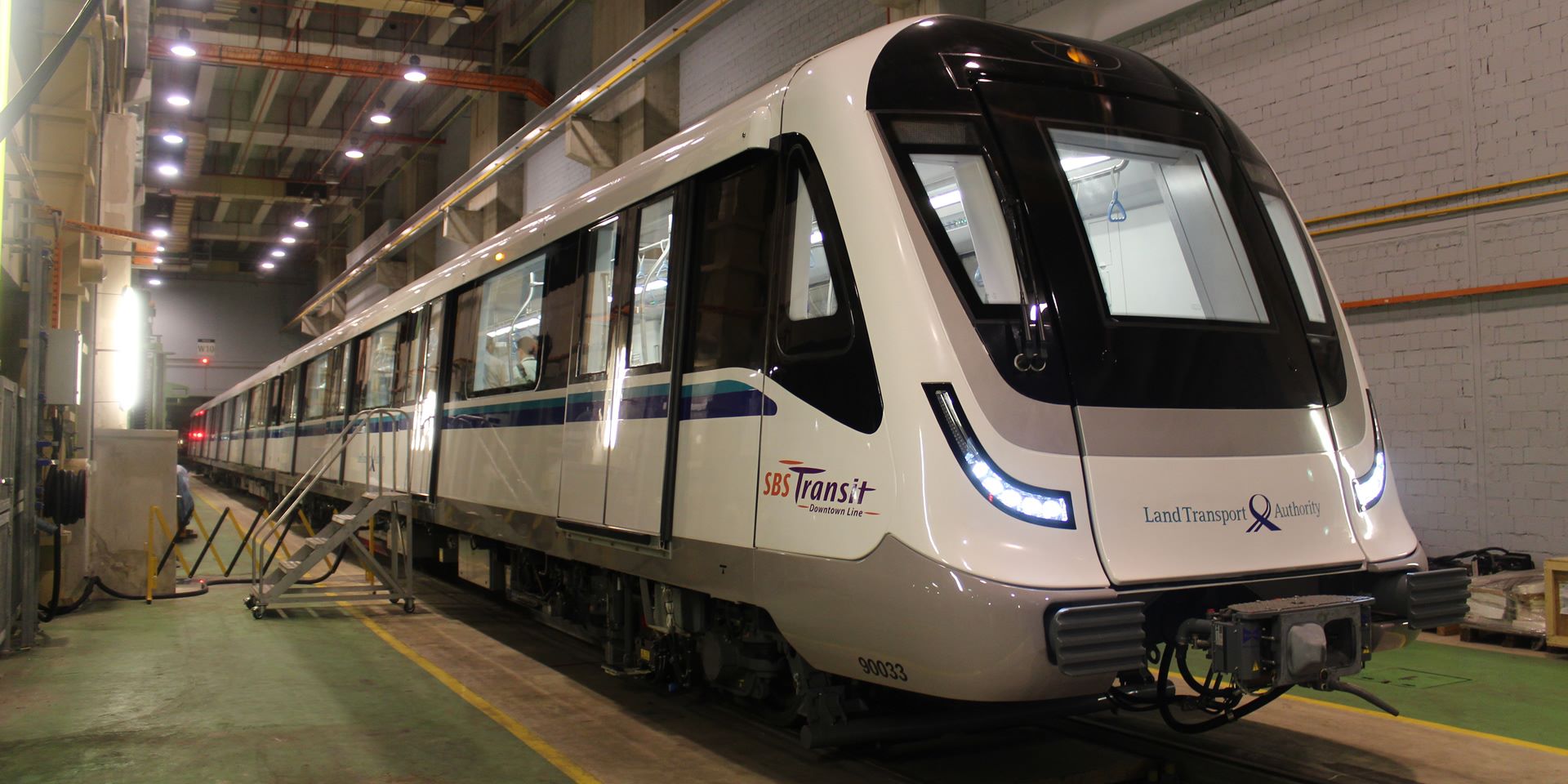
A Downtown Line train with a carrying capacity of 931.
Before you go all out happy and say “oh that’s why we don’t need buses anymore, hooray!” (I’ll be getting you to read this first though), let’s do a bit more math:
If we run DTL trains at 2 minute frequencies, we get a corridor carrying capacity of 27,930 ppdph. Pathetic in comparison to the 69,120 ppdph that the NSEWL achieves, but I’ll deal with that another time. This 27,930 figure, is also your limit, should you choose to de-duplicate all your buses from rail lines, effectively meaning only the DTL itself exists along this corridor, the others merely coming in with a long feeder or feeder role.
Let’s say, if we operated a few bus routes, each running at 10 minute frequencies during peak hour. (Ideally it should be 5, but 10 is good enough.) For Bedok Reservoir, we originally have eight such routes. Let’s plug in the numbers and see what your total corridor carrying capacity is like, assuming 120 per bus, and that gives 33,690 ppdph. One shouldn’t underestimate this extra 5,760 people that can be carried, because remember that people want to go places, and they can lie anywhere, on the corridor, off the corridor, or in some far-flung place!
If we took out three of such routes, that gives 5 routes operating at 10 min headways, giving a total corridor capacity when combined with DTL’s 27930 ppdph, giving just 31,530 ppdph! One such service cut exercise alone will deny access opportunities to more than two thousand people, such is the power of bus routes — not in individual quality, but simply in their numbers!
Remember, every time a service is cut, you are denying thousands of people their ability to go places, because they simply will not be able to get on! Capacity problems are already a ticking time bomb on the western side of Singapore. Are we now going to dig ourselves a grave on the Eastern side too? Whoever proposed such a service amendment is undoubtedly ridiculous beyond belief, a prime example of silo culture combined with an ivory tower mindset, the consequence of having motorists planning public transportation. The former has a heavily infrastructure-based mindset, while the latter is more service-intensive, and that makes all the difference in why local public transport is going downhill. If they say Europe is two to three decades behind the USA in decline, then we must be just one decade behind, having bought wholesale into their sickening neoliberal ideology as the Cold War ended, now being an almost carbon copy of American society, with the exception of having a strongly single-party-ruled state still being a differentiating factor between them and us.
I mean, Tower Transit (Service 66’s current operator) may be completely horrid and inept at running buses, having daily breakdown streaks, topping the crash leaderboard, and impressing us (not the good way) every time by breaking records with ever-worse bus intervals, but hey, at least Service 66 exists! Like what I said with expressway buses, if it sucks like hell, the solution is never to destroy it outright, but rather find ways to improve it! Heck, I rather the Jurong East-Bedok route get transferred to another bus package, than get guttered, because no matter how bad it is, it is still a critical trunk connector that serves large numbers of people! It’s just potential that isn’t being realised.
Something concerning accidentally revealed
Besides these losses in terms of service as irrationalisation goes on, each round getting more crazy, I’ve noticed something about this amendment exercise which clearly indicates that this, not being the first in such mindless service guttering, will not be the last, and there is full-on intent to continue guttering bus service in Singapore, destroying their presence completely. I can bet you a fortune on that. The observation? Where these trunk routes were shortened to.
Pay attention to the 22 and 506 posters again. Note the new termini of these routes.


Here’s the Eunos and Serangoon bus interchanges:


If you haven’t already noticed, both bus interchanges are awfully small and have terrible capacity! In the case of Serangoon Interchange, it is so bad they had to kick out two bus routes when they moved into the new co-located-with-NEX facility, a prime example of deciding service levels by infrastructure! Other negative effects of such small bus terminating facilities include:
- Rampant overcrowding issues
- Poor service reliability
- As 81 and 82 have been amended to be loop routes, their reliability takes a hit due to the longer distance travelled on each trip before they reach the bus interchange which has the ability to stabilise bus intervals
- Serangoon Interchange also sees congestion on the bus driveways, caused as the bus park is unable to handle so many buses from even the current reduced route palette! A common occurrence: Buses parking at the alighting berths to wait out a slot in the bus park.
- Poor bus frequency
- No-brainer: Fewer parking lots mean fewer available for each bus route, because driver breaks have to be factored in. Unless, of course, you’re TTS and you try to do jumpbus, but that makes your overall schedule more prone to delays, where one delay causes a domino effect across multiple routes.
With these two bus interchanges that are already struggling with what they already have, what more adding more bus routes? It doesn’t take Sherlock Holmes-level detective work to realise there’s something hugely amiss with what is going on!
Look, I kind of see what they were trying to do with 506 — to in a way act as the supposed hypothetical “205” that a former STC author proposed last year, offering a faster connection between the North East and the (south?)-western regions of Singapore, something like 74 but “better”.

Except, when you route it to Serangoon Int, and ask it to terminate there, there’s a few things left to be desired. First up, why terminate it short of the main population agglomerations in Hougang, Sengkang and Punggol? Wouldn’t this still not be able to resolve the problem of overcrowding on the North-East Line, which has been proven to be behind some NEL disruptions before? And just why would you fling it, of all places, to a bus interchange that is already over capacity?
I suspect, that the act of routing more bus routes, shortening them to already bursting bus interchanges that clearly are unable to handle the extra service, is simply a pretext for LTA to do more. And do far worse things to the bus network than what we have seen so far. You see, when you start stuffing more routes into overloaded bus interchanges, naturally some other routes will have to go, which is pretty much going to continue down a vicious cycle, as more bus routes get cut, shortened, amended, further affecting even more bus routes, and you’re pretty much embarked on the journey of no return. In this case, I can forsee parallel routes to 22 and 506 terminating at the Eunos and Serangoon interchanges respectively receiving the axe soon. You know, for instance, 76 (Yio Chu Kang – Eunos), 105 (Serangoon – Jurong East), and so on.
Edit 12/6/23: It has come to our attention that LTA intends to cut short many major trunk bus routes in the east being cut short to terminate at Eunos interchange, 51 and 966 being two of them. This is appalling, considering Eunos interchange is already over-capacity since the amendment of bus 22 to terminate there since December 2021.
The spiel against bus irrationalisation
This is the part where I, getting increasingly fed up with LTA’s bullshit drivel of cutting bus service endlessly and mindlessly, put out one single post explaining why bus irrationalisation, LTA’s favourite signature policy, is a horrible idea, and why you definitely should not be doing it, whether you’re Singapore, or some other city. Cross-posted with another post containing specifically this.
Update 12/6/23: I will not update the entries here to include new pointers against bus rationalisation due to some backend constraints of the site, but latest versions of this case made with all the new points can always be accessed on the cross post, which will continue to be updated.
Bus rationalisation, as LTA claims, is the practice of cutting back bus services, for the purpose of better “resource utilisation”, to “avoid duplication”, be it with rail lines, or other bus routes. Typically, the target of these service cuts is usually rapid routes or trunk routes, which get affected most disproportionately. However, as I mentioned in my route types Basics post, trunk routes are, remember, your “glue” that holds the entire transport network together, without which the city would pretty much collapse!
Here’s a full list of reasons why bus rationalisation is a horrible idea, and why LTA should not be conducting bus rationalisation!
Why Bus Rationalisation is a Bad Idea
Train Capacity is Not Infinite
Some people think, that with trains that have capacities of 1,920 passengers each, operating at every 100 seconds (assuming we’re even doing that), we can eliminate the need for buses altogether, because, they have lower capacities, and suck away our “valuable resources”, right?
Well then, let’s go back to school! Basic math lesson time: what is infinity?

Is 70,000, infinity?
Is 100,000 infinity?
Is 1,000,000 infinity?
Is ten gazillion billion billion million trillion, infinity?
If your answer is no, then this first logical fallacy of LTA planning should be dead obvious to you! Somehow, the related powers make the grand mistake of equating “high capacity” to “infinite capacity”, especially seen in cases pertaining to irrationalisation exercises for rail lines with lower train capacities!
In both this year and last year, when LTA guttered bus services in Bukit Panjang and Bedok Reservoir, it was done for the sole purpose of stuffing more people onto the Downtown Line, and even LTA admits this, in the form of advisories advising passengers to choose riding the DTL instead! This comes even as the Downtown Line, currently running at 2 minute headways during peak hours, is already operating at 95 percent capacity and above, even before the COVID-19 pandemic hit our shores!
If the DTL was really having a dismal ridership number, then it might have made some sense to cut a few bus services to feed into the DTL’s ridership numbers, but hello, we’re speaking of trains running ninety-five percent full during peak hours, and you’re still talking about squeezing more people onto the train? No matter how much higher the capacity of a rail line may be in comparison to a bus route, LTA must never forget that there is a “glass ceiling”, a limit to the carrying capacity of a rail line! Why else then, are Japanese trains, snaking ten- to sixteen-car monstrosities that carry three to five thousand passengers at one go, still crowded to the brim, requiring a special job called people-pushers to keep running? Because Japanese rail operators and transport regulators disrespected this limit to the capacity of rail lines, continually destroying bus services and sending ever more passengers into already overwhelmed trains!
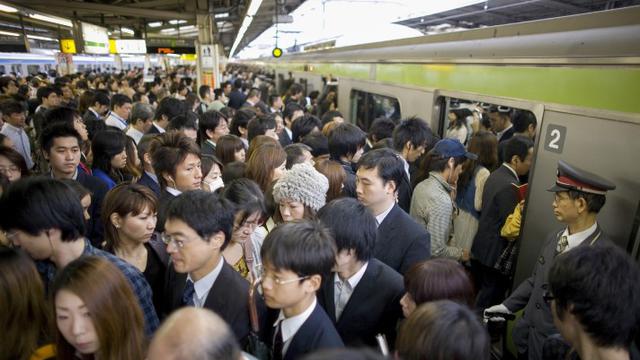
What also happens if you disrespect this limit? You get this:
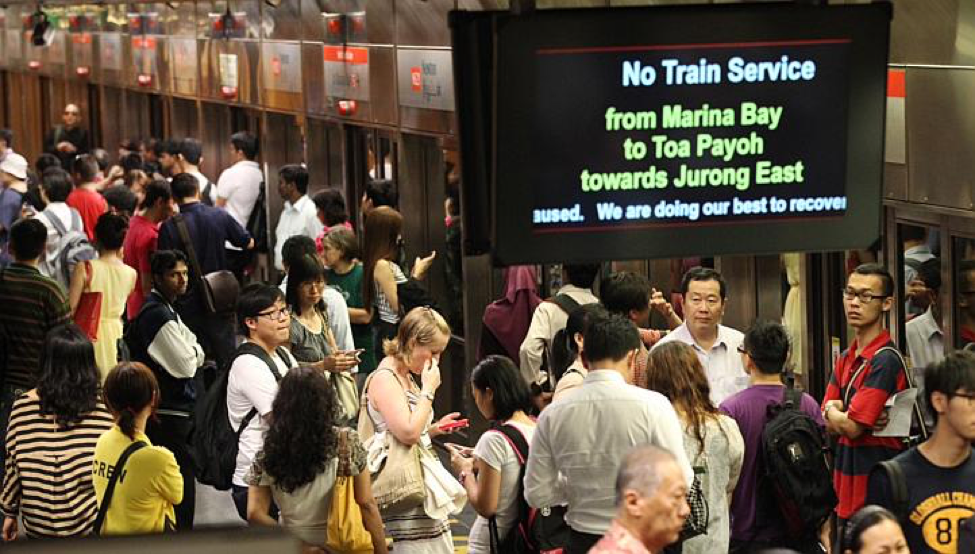
As I explained last year, the three-line breakdown mania isn’t rocket science: it’s simply a problem of the Western side of Singapore having insufficient travel alternatives to the MRT, causing overcrowding and the burnout of critical components required for trains to run smoothly and safely!
Yes, trains are big. But they are not infinitely big. If your trains are already reaching capacity, you are nothing short of a total idiot to continue feeding more passengers into the system through disgusting methods like destruction of bus service!
Which brings me onto my next point…
What Happens If Things Go Wrong?
Let’s hypothetically say that you’ve managed to finally eliminate all those pesky buses that are competing for passengers with your rail lines (what nonsensical rhetoric, but that’s pretty much exactly how the LTA masterplan thinks). Let’s say you’ve found ways for the rail lines to accommodate all those people, by hook or by crook. Say, you extended trains to match their Japanese counterparts, or something. And you extra-strengthened your components to withstand additional duress. It is all running smooth as silk. “Ha, I’m right, you’re dead wrong, buses are really irrelevant! Look at how the trains alone can handle everything, without anything going wrong! It’s perfect! I’m saving all the money that was once used to run duplicative and half-empty buses! Woohoo!”
To which I say, “Right.”

Until you turn around and suddenly realise to your horror, that a component still fails nonetheless, and once again, your train has broken down!
Now, since you have eliminated all your “annoying” trunk bus routes, suddenly, a huuuuuuuuuuuuuuuuuuuuuuuuuuuuuuge-ass capacity vacuum appears.
Whereas in the “resource-intensive” past, you would have other trunk bus routes that might have come to lend you a helping hand:
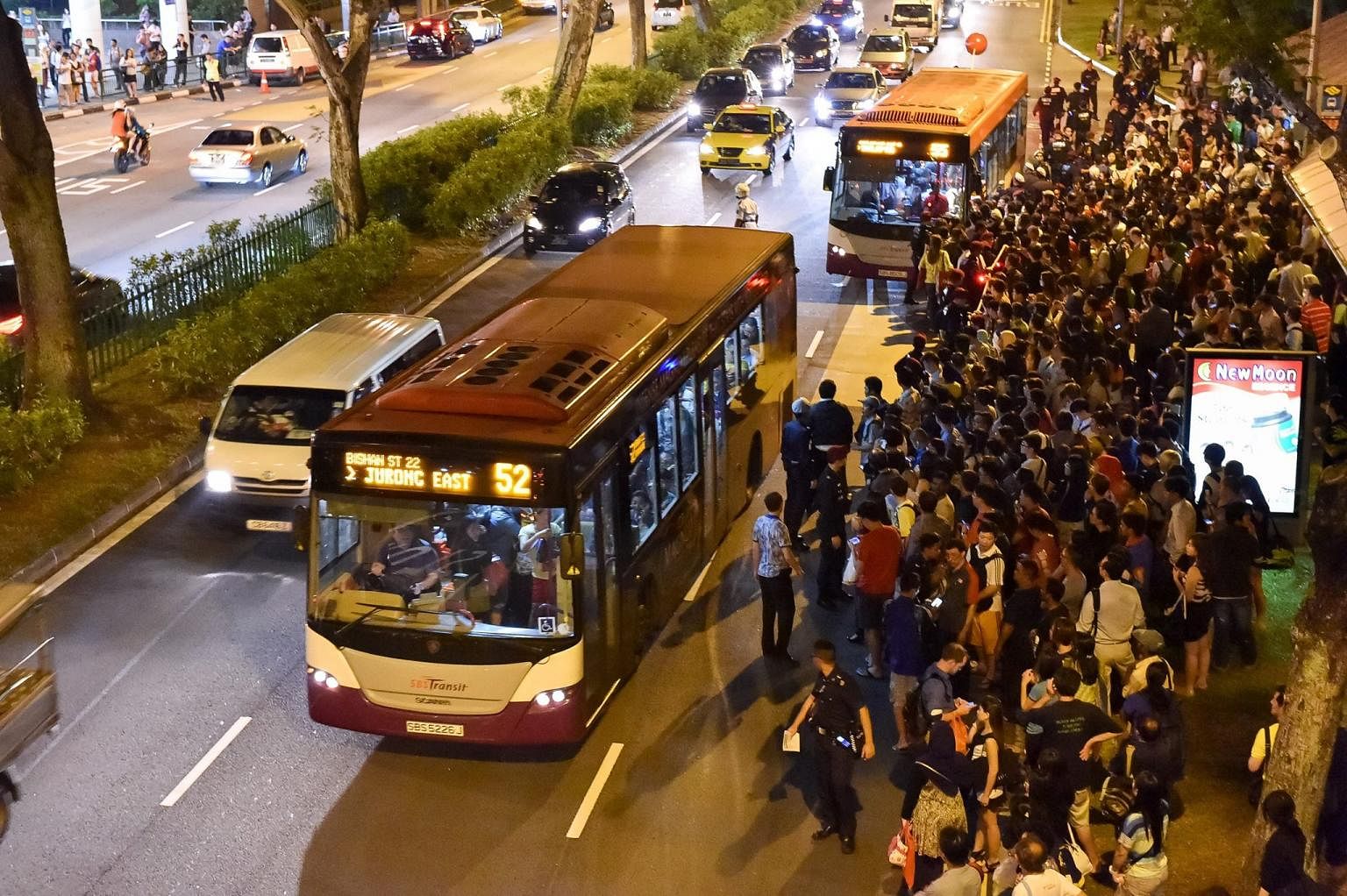
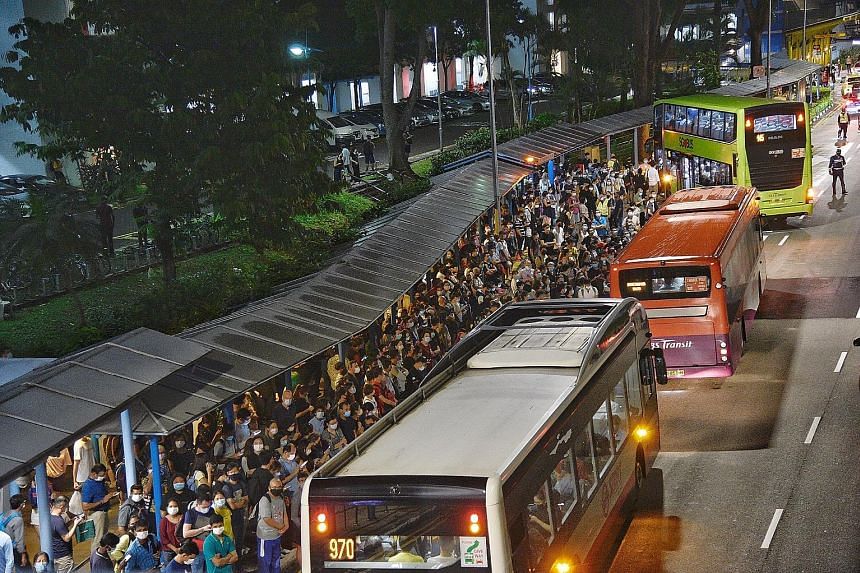
Now that you’ve gotten rid of them all, the only possible transport you have now for millions of stranded passengers is… a few pathetic “bridging buses”. Remind me, how many buses do you need again if you are talking about 500,000 people who want to get somewhere in time?
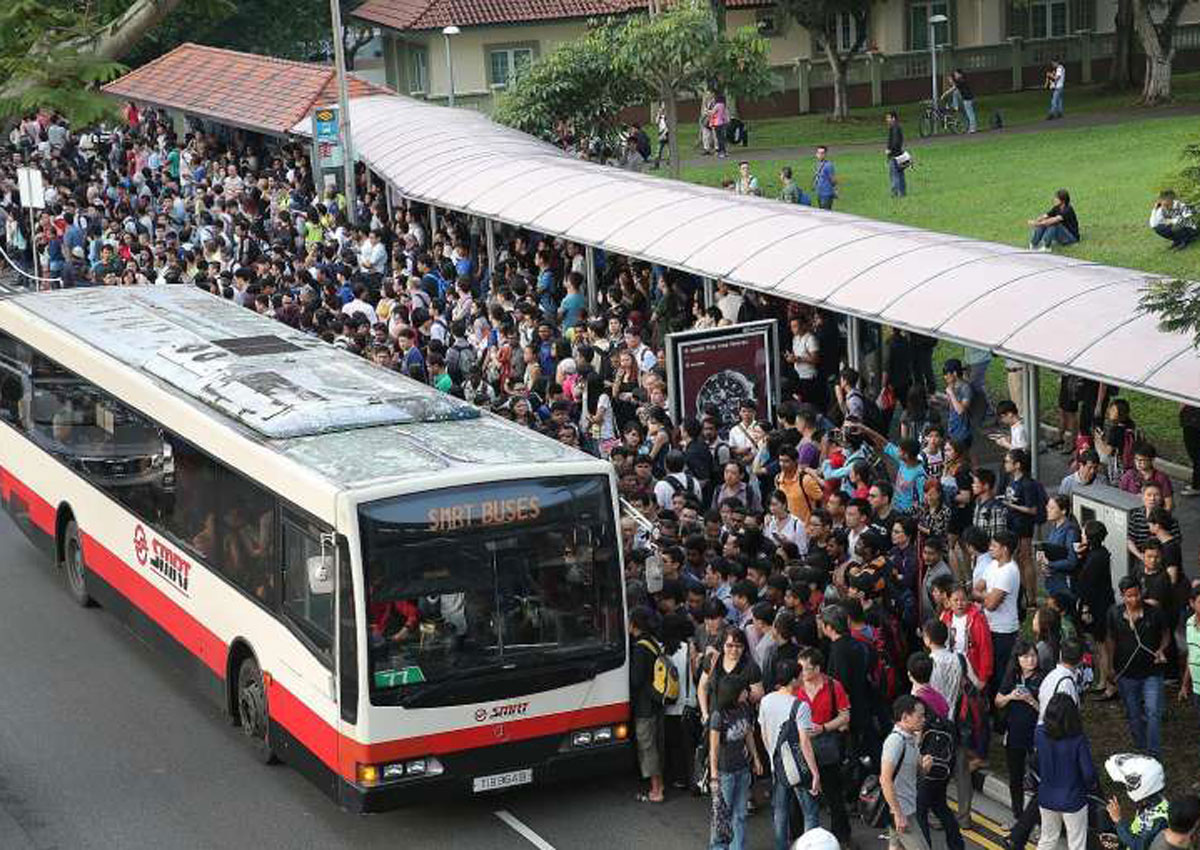
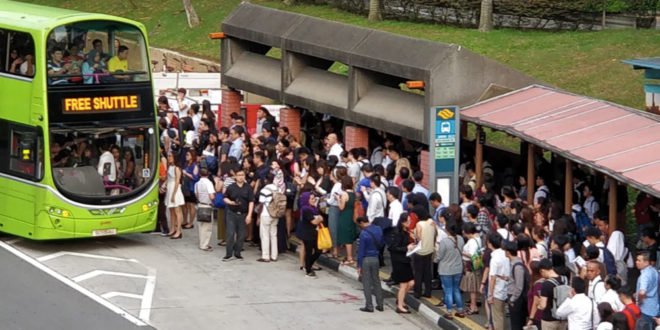
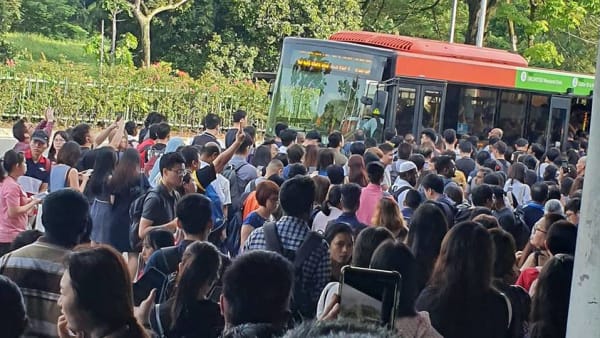

Are a few puny “bridging buses” going to be enough to cover everything spilling out? Obviously not! If this is the future you want, sure, go ahead and continue cutting up bus services! Ridonkulous!
You’re Going to Cause More Breakdowns, Anyways.
With more and more trunk routes getting guttered and completely thrown out, discarded, faded, forgotten, LTA’s objectives of making MRT the primary form of public transport is getting a closer by a few more steps each time.
Our future selves, and our children who will still be riding the public transport system we leave behind for them, will not be thanking us for such an achievement.
As we approach LTA’s goal to relegate buses to second-class transport, we will be consistently increasing train loads, as we continue forcing (Yes) ever more people into the same rail lines! Can however, the trains withstand the collective force exerted on its components as we force more people on board? I honestly don’t care about “rigourous safety standards” that LTA enforces on new rolling stock, because at one point in the future when we’ve run out of all alternative forms of transport to the MRT we will be doing exactly what Japan is doing today, that is to overload the trains, simply cause we have no choice!
Even today, Japanese trains are still running at… 163% capacity! Is this the future that we are promising for future Singaporeans?

More importantly, is our infrastructure able to withstand greater demands? As we start overloading our trains, pushing the number of people in each train beyond two thousand (the current crush load capacity being 1,920), have we ever considered the additional power that the trains’ components will have to be drawing from the electrical system in order to still be able to drive the trains as they are today? Have we considered what might happen to the electrical system itself as each train draws ever increasing amounts of electrical power from the cables? Can our electrical infrastructure handle this? Yes, we may have upgraded our cables after what happened in 2020. Will it be sufficient to handle a future where we are running our trains at 150% capacity precisely because there are no buses to pick up additional demand?
We Are Running Out of Time
By 2030, Singapore’s population is projected to reach 6.9 million. A sure certainty that our population will continue to rise rapidly, despite protests from almost all sectors of society here against the government’s proposal.

Even so, with prospects of hitting New York-levels of population density across our entire island by the middle of this century, our public transport projects are severly lacking!
This is the projected 2040 MRT map, when Singapore will be home to eight million, almost double the current number of five-and-a-half:
Ostensibly, what we are doing is severely insufficient! With most of the “greater” rail projects now having deadlines beyond 2030 now that COVID-19 has disrupted construction schedules, we are pretty much looking at walking towards our 6.9 million population with just this:
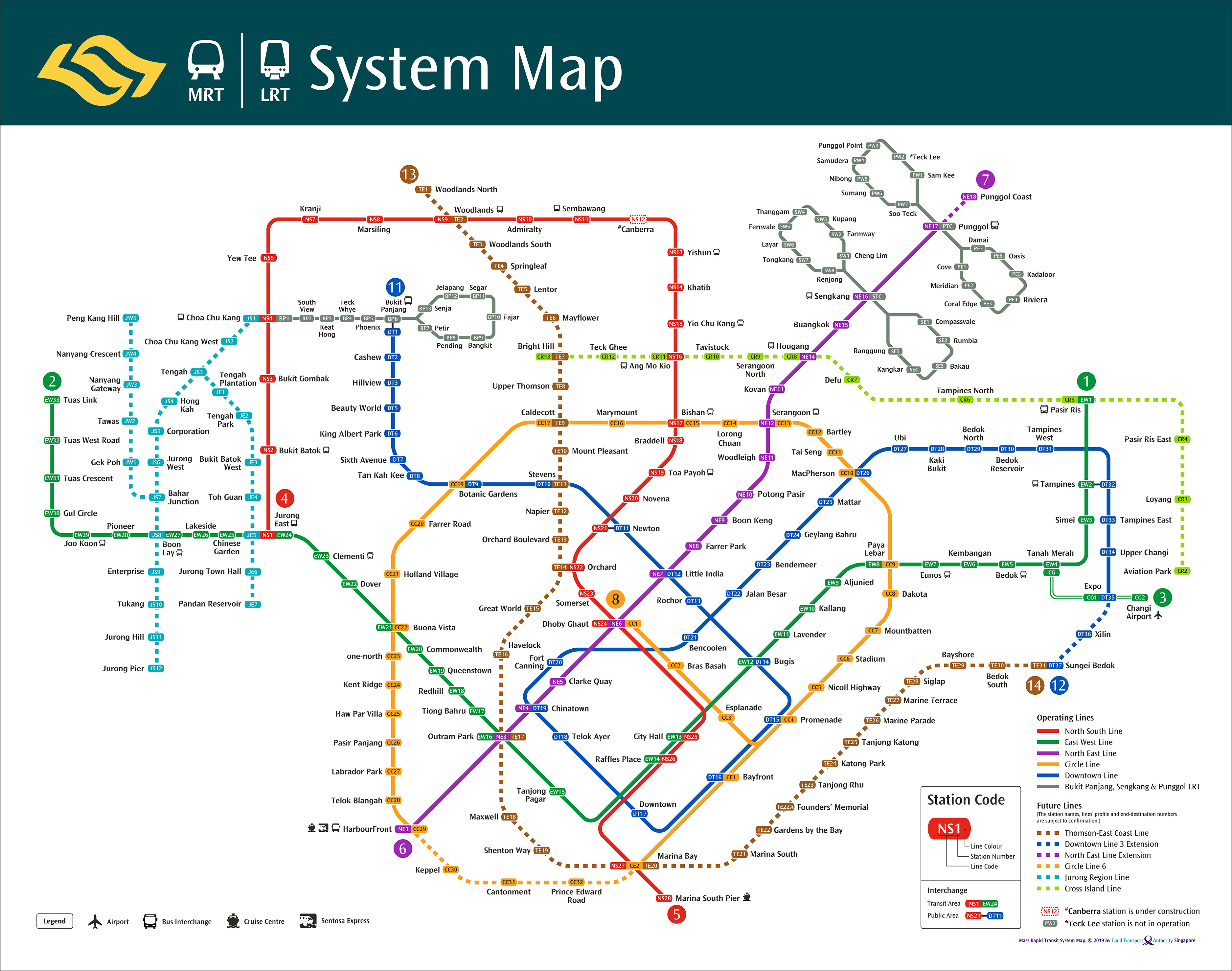
We don’t even have the time now to prepare additional rail infrastructure to cope with greater demands that come alongside population increases (or say, explosions), and we’re still talking about destroying alternative transport means that could potentially absorb some of the demand while we scramble to get everything ready?
Our population is increasing, yet LTA is trying to decrease our overall transport capacity? Where can I get some of what you’re smoking, the folks in the LTMP planning department?
Unsuitable Rail Network Shape
By 2030, the Central Business District in Marina Bay/Raffles Place will no longer be the only “key activity area” in Singapore, as it will be accompanied by other developments such as the Punggol Digital District, Jurong Lake District and Tengah New Town. Such decentralisation efforts are worthy of commendation, as it shows that there is at least some awareness in government that a monocentric urban core planning approach is unsustainable for long-term development. Unfortunately, I don’t think LTA has got the memo…
The rail network at its present stage is still a heavily radial and orbital-based system, with the CBD as the centerpoint of everything, and all rail projects in the next five years are headed still in this direction.


It is still heavily unsuitable for these key activity areas that are expecting a flurry of activity in the years to come!
Look at the PDD! Only one line! How can this be considered a “key activity area”, with such poor connections to the rest of the transport network?

Same goes for the Tengah New Town! What’s this, being served only by feeder (light) rail lines?

LTA’s radial-centric approach to planning rail lines has already been an abject failure in serving adequately the needs of these emerging key activity areas, even before they have been built! To correct this undesirable trend, we need to shift the overall transport network shape into a more all-destination, all-day type, especially as Singapore decentralises and the workforce is transformed in ways that we may not be able to anticipate in future! What better way, then to do this network shape transformation, than to harness the overwhelming power that trunk buses, and any type of bus for that matter, to create a lively and liberating system that benefits everyone regardless of where they’re going?
Enjoy Your Transfers In Moderation
Transfers are good, to some extent, since they strengthen the overall network effect (something I talk about later).
Yet too many transfers is not something that should be encouraged! (Logical fallacy #2: Transfers are good right? Let’s give you as many as possible!)
Here’s a hypothetical transport network arranged in the “hub-and-spoke” configuration. (Pulled from my Basics explainer on route types)

Let’s say you intend to travel from point A to point B.

In a fully rationalised world, you would need to make three transfers, just in order to get from A to B, which should, and in this case, does indeed, lie on a straight line! You’d have to take a feeder to the red line, go “downtown”, change to the blue line, and change to the feeder that takes you to B. As I said, these service cuts, aka bus irrationalisation exercises, have the key feature of increasing your travel time needed as you have to wait for buses or trains more (simply because you transfer more times!)

When you could have had a trunk bus route that would have given you a straighter journey, saving you much time! Hypothetical “straighter trunk” in pink below.

People are not travelling for leisure! They have a job to rush to, school to attend, things to buy, friends to meet, the list goes on. Singapore is one of the most time-tight countries in the world (we’re called a “hurry-cane” country, with the fastest paces in the world), and it doesn’t help that we have immense sprawl, with towns scattered all over the damn place! Every minute in a journey matters, no matter if its spent on a bus, in a train, waiting somewhere, or getting stuck in traffic! That’s why transfers may be good, but too many transfers, as seems to be what LTA is suggesting instead, is not!
Like all good things in life, transfers in public transit systems are meant to be enjoyed in moderation. We don’t appreciate cases like Hong Kong where you have to transfer five times to get from your home in a northwestern suburb to the other end in Ma On Shan.
Trunk buses do one good, and that’s to reduce the number of transfers to a healthy level. Let’s keep it that way.
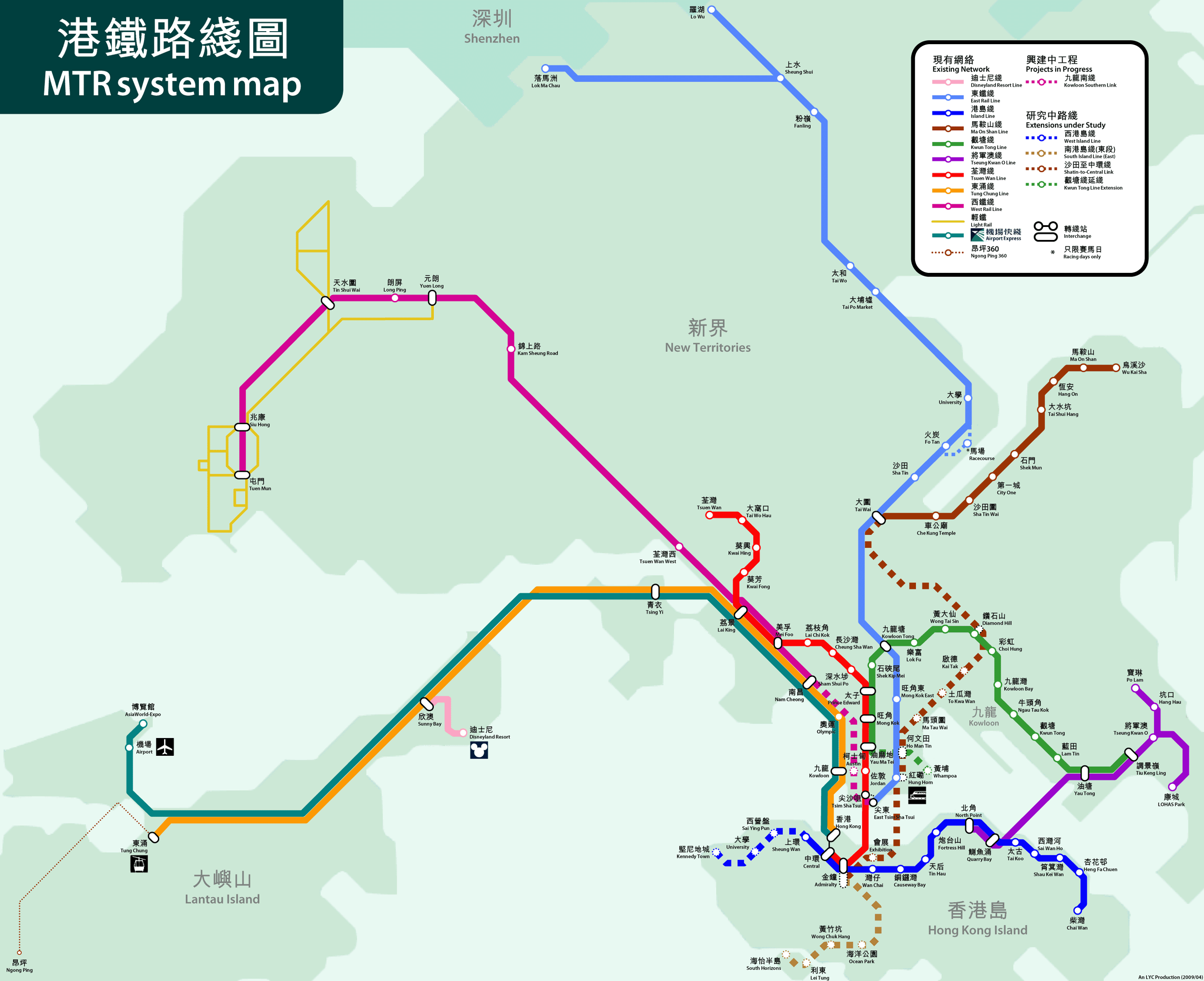
Those were five reasons, why any city, not just Singapore, should not be engaging in bus rationalisation activities! On a fundamental level, it destroys the public transport system by cutting at the very glue that holds everything together, that is your trunk bus routes! Without them, no matter how much you talk about “connectivity”, you would be laughed off the street for being lyrical if not hypocritical. Because the greatest “connector” of them all, is not an orbital rail line, or more light rail lines (Ahem, CCL, DTL), or more rapid transit lines, but your basic trunk bus route. They are the ones that studiously call at every stop and make sure, that wherever you are, even if you’re on a train, that you’ll remain connected to the rest of the network, able to access your destination in a reasonable time.
To cut at the very fundamental level of a public transport system such as the trunk bus route, is a blatant disrespect for how public transport works, and to justify rationalisation through certain “advantages” of rail lines is nothing more than sheer ignorance, or worse an intent to wreck a public transport system for decades to come.
LTA seems to have interpreted this year’s National Day theme song in a vastly different way:
Come whatever on the road ahead, we did it before, and we’ll do it again.
The Road Ahead, Linying 2021
You have thrown rocks at our future before, and now you’re throwing a grenade on the road ahead, that we’ll walk some day and get severely maimed by.
Bus rationalisation is not justified, no matter what. To usurp buses due to rail’s existence, I repeat, is sheer disrespect for public transport as a whole, including buses, and trains.
On a side note, Sydney is also in an uproar over their own version of bus irrationalisation, involving 24 routes being cut and dozens more amended, instead of our four. They’re planning on riots and demonstrations to send a crystal clear message to their municipal government, and I wish them all the best.
I’ll update this post from time to time if I ever think of more reasons why bus irrationalisation is a terrible idea.
Liked this article? Sub, like and share this post, to spread the love around! E:3


Fuck LTA about making these bus rationalisations. They must be slapped on the face
LikeLike
Again LTA making bus rationalisations. They should stop
LikeLiked by 1 person
I took the downtown line from MacPherson to Tampines and it is squeezy as fk. All three cabins were full and i had to take the next one, and i had to wait 2 min for another train. I sometimes wonder if the people planning all these even have brain and common sense.
LikeLike
If a network wide breakdown of subway trains and railway system occurs just before rush hour like in Tokyo area after Great East Japan Earthquake (Friday, March 11th 2011), there will be a severe traffic congestion across the area to the point of gridlock, where vehicles cannot move. Buses and pavements will be overwhelmed with passengers and commuters trying to go home, which can lead to severe problems with operation of emergency vehicles.
LikeLike
Hong Kong, for now, you don’t need to transfer five times from a northwestern suburb to Ma On Shan, because Ma On Shan line and West Rail line have been linked to form Tuen Ma Line for trains running through the new segment to connect both lines. And East Rail line has been extended to Admiralty, Hong Kong’s CBD.
LikeLike